
Andy Lloyd's Dark Star Blog

Blog 53 (August 2017)
August: The Traditional Planet X Silly Season
I've noticed that August usually brings with it a significant uptick in Planet X-related stories in the mainstream media. Lots of people go on holiday, companies go quiet, governments tick along and seek only to bury bad news this month, and no one's playing much attention anyway. So, bored journalists stuck in their offices when everyone else is having fun scrabble around to produce stories, sometimes from nothing at all, other times re-hashing previous material. More often than not, they simply nick each other's ideas. This year, the traditional August silly season has been marred by the rather unfortunate possibility of nuclear war. This kind of serious topic has no place in August, so most people seem to be consigning it to the desperate summer news schedule. I'm sure that if the threat of war on the Korean peninsula continues into September, then people will start to sit up and take notice, with the commensurate impact on stock markets, prospects of mass annihilation, etc.
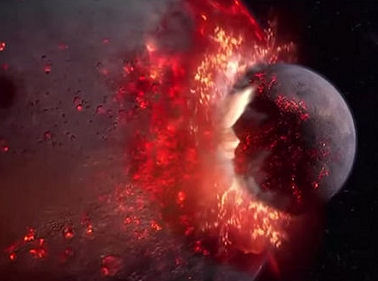
Image credit: Lifted off YouTube by the Daily Express, no credits given
Anyhow, within that context, it's little surprise to see a story outlining the fears people have about Planet X, and how there may actually be an underlying reality behind the conspiracy theories (which there often is, in one form or another). The celestial ball gets rolling by an online article in the Daily Star (1) which outlines the most recent nightmare scenario from the heavens, and then includes a family-friendly Planet X rebuttal on a YouTube video by NASA scientist David Morrison. Some of the detailed points he makes are arguable (about 'Nibiru' being a 'minor god in the Babylonian pantheon', and about how great an effect a perihelion transit by a Planet X object might have upon the solar system's architecture, for instance) but his general thrust is sound. Don't panic!
So, generally this tabloid article comes across as quite comforting for Daily Star readers flicking through the latest post-modern prospects for the apocalypse. Within hours of this publication is a more alarming article in the Daily Mail, warning its readers that claims have been made by an American author, David Meade, that the mysterious planet Nibiru will soon crash into the Earth (2). The author has brought forward Nibiru's schedule by a month, based upon a total solar eclipse set to occur on 21st August. This will be witnessed across the United States by millions of people (lucky them!) and is a sure sign of impending Armageddon, he claims:
"Earlier this year, Mr Meade claimed that Nibiru would clash with Earth in October after being driven here by the gravitational pull from a 'binary star' twinned with the sun. He said the star is difficult to spot because of the angle it is approaching Earth. Now the conspiracy theorist has moved his date forward, claiming that the upcoming 'Great American Eclipse' will signal the planet's arrival." (2)
Then, writing for another British 'red top' tabloid, the Daily Express, Jon Austin takes a long hard look at Planet X Nibiru conspiracies on the Internet. From doomsday prophecies of impending planetary impacts, to planets behind the Sun, to the imminent advent of a Second Coming (along with the now obligatory fundamentalist 'Rapture') to Russian media announcements, he does a pretty decent job of tying together the various threads of doom (3). In typical churnalism style, the story continues to get picked up and propagated, this time by another British newspaper, 'The Telegraph', which may once have been considered a high brow news outlet (4). And so it goes on...
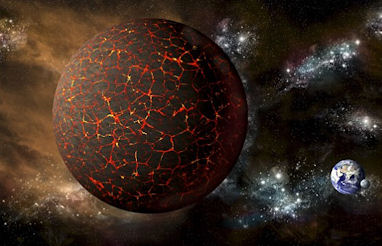
Image credit: Getty images/Stocktrek images
This year's Nibiru threat takes a similar form to those of previous years, and decades (2003 and 2012 being vintage years). The trigger point for this year's non-event is a total solar eclipse which will be seen across the United States next week:
"The “Nibiru Cataclysm” movement claims the eclipse heralds the end of the world and the arrival of Nibiru. Christian numerologist David Meade predicts Nibiru will appear in the skies on September 23, just over a month after the eclipse warning sign. His book Planet X – The 2017 Arrival, claims there will be a close pass of Nibiru or even a direct impact. His analysis is based on Bible verses and planetary and star alignments, reports Dailystar.co.uk. He said: "The Great American Eclipse of August 21, 2017, is a major – huge – harbinger.”" (3)
Oh boy. Let's unpick this a little. Admittedly, with all the recent talk of a new Korean war, perhaps things aren't looking too good right now. But the prospect of Nibiru, or Planet X, 'appearing in our skies' is zero. Yes, zero. As the article rightly points out, objects in the solar system don't suddenly appear out of thin air, especially those transiting from the outer solar system. It takes years for them to move through the orbits of the planets to get within striking distance, and even amateur astronomers with backyard telescopes can pick up comets at quite a significant distance out from us in our cosy inner solar system sanctum. An incoming planet would easily have been spotted within the planetary zone some time back, if it was truly about to become a visible object in our skies.
Some argue, and provide what they consider to be photographic and video evidence, of a planet hiding behind the Sun which will imminently pop out into the open. Again, not possible. The Earth moves around the Sun at a considerable clip compared to the slow-coaches from the outer solar system. So, much of a distant body's apparent movement across the sky is attributable to the Earth's own relative speed of transit around the Sun. Of course, planets do 'disappear' behind the Sun during their movements relative to us, perhaps for a month or two when the glare of the Sun wipes out their own dim reflected glow. Sometimes they are actually eclipsed. But they cannot remain there for long - it's just a matter of celestial mechanics. The planets continue their perpetual dance and reappear again.
So it would be with Nibiru. These images of 'two suns' have been appearing for years and years. They can't all be true, because a planet from the outer solar system could not disappear behind the Sun for that length of time. So, which ones are true and which ones aren't? They all look the same. Which is because they are all lens flares, sundogs, camera artefacts from pointing an optical device at a bright local star and seeing how it handles the glare. Not particularly well, it turns out.
Alternative claims have been made that Planet X Nibiru is approaching from the south, and is therefore blocked from view by observers in the Northern hemisphere. This is a ridiculous argument, because there are plenty of telescopes in the southern hemisphere perfectly capable of spotting a southern object. Erroneously, David Meade takes this long-running theme up within his toolkit of Planet X regurgitation:
"Writing a piece for Planet X News (5)
in January (sic), Mr Meade said: 'This system is, of course, not aligned with our solar system's ecliptic, but is coming to us from an oblique angle and toward our South Pole. 'This makes observations difficult, unless you're flying at a high altitude over South America with an excellent camera. In his book, he claims to put forward scientific evidence, but readers commenting on the book say the argument quickly develops into a religious argument." (2)I've not read the book, so I can't comment on the last quote about his less-than-scientific approach. But it's fair to say that the newspaper articles currently circulating make it plain to see that this fresh Planet X debate is driven by religious ideology and prophecy:
"Mr Meade said it was written in the Old Testament book of Isaiah, Chapter 13, verses nine to 10, which state: “See, the Day of the LORD is coming – a cruel day, with wrath and fierce anger – to make the land desolate and destroy the sinners within it. “The Stars of Heaven and their constellations will not show their light. The rising Sun will be darkened and the Moon will not give its light.”
"He said there was a stunning numerical coincidence that he calls the “33 Convergence”. Mr Meade added: “When the eclipse begins on August 21, the sunrise will be dark, just as Isaiah predicts. “The Moon involved is called a black moon. These occur about every 33 months. In the Bible, the divine name of Elohim appears 33 times in Genesis. “The eclipse will start in Lincoln Beach, Oregon – the 33rd state – and end on the 33rd degree of Charleston, South Carolina. “Such a solar eclipse has not occurred since 1918, which is 99 years – or 33 times three.”
"He worked out the end of the world date based on this coincidence: Thirty three days after the eclipse, the stars will align exactly as the book of Revelation says they will before the end of the world. That date is September 23, 2017, he says. He said the eclipse enters through the 33rd US state, exits at the 33rd latitude by Charleston, and occurs 33 days out from the Great Sign of Revelation 12. He added: “This is indeed an amazing omen and a frightful sign.”" (3)
He's not alone in believing that the solar eclipse is an omen. But David Meade goes further by linking it to forthcoming Planet X-related doom in his book (6). Here's the thing. Nibiru is not a Christian invention. It is even not a Biblical story (although, arguably, relevant parts of The Book of Genesis may have been lifted from previous ancient Middle Eastern sources whose creation myths allude to the Nibiru mystery). Let's be frank - Nibiru stems from a pre-Biblical pagan polytheistic tradition. If fundamentalist Christians have co-opted it for their own, then it's simply because it conveniently plays into their own dark narratives. Their stance is, at best, ironic, if you think about it. Normally, they spend their time damning the old religions. Not as bad as fundamentalist Muslims from so-called IS destroying the ancient monuments, it's true, but a general antipathy, nonetheless.
If Nibiru is a bona fide Planet X object, as originally proposed by Zecharia Sitchin (an independently minded Jewish writer and scholar) (7), then it is currently way out in the solar system, offering no imminent threat whatsoever. True, its discovery out there may upset various academic apple-carts, but it is not about to destroy our world. We're quite capable of doing that ourselves, and need no help from distant planets, however much they may act as celestial omens of doom in some people's eyes.
Written by Andy Lloyd, 12th August 2017
References:
1) David Trayner "Solar eclipse ‘reveals exact date Nibiru will destroy Earth…and it’s NEXT MONTH’" 7 August 2017
2) Harry Pettit, "Will the world end this month? Conspiracy theorists claim the upcoming solar eclipse will cause the mysterious planet 'Nibiru' to smash into Earth", 7 August 2017,
3) Jon Austin "NASA confirms Planet X EXISTS but could mythical Nibiru really DESTROY earth next month?" 9 August 2017, with thanks to Kevin
4) Eleanor Muffitt "Will 2017 solar eclipse cause secret planet 'Nibiru' to destroy Earth next month? (No, but conspiracy theorists think so)" 11 August 2017
5) David Meade "Overwhelming Evidence for the 2017 Arrival of Planet X/Nibiru" 16 June 2016 ( no longer available online)
6) David Meade "Planet X – The 2017 Arrival" ebookit.com 2016
7) Zecharia Sitchin "The Twelfth Planet" Avon Books 1976
Update on the Hunt for Planet X
A recent article in an engineering magazine discusses the subject of Planet Nine in great depth. As well as providing snippets of an interview with Mike Brown from Caltech, it provides a useful guide to the variety of searches currently being carried out to locate this elusive object (1). Mike Brown remains convinced that a Neptune-sized ninth planet is out there, located a couple of dozen of times further out from us than Neptune itself. The planet's orbit is eccentric and highly inclined, he argues, providing an off-set torque which has caused the entire solar system to twist out of shape over time. The existence of Planet Nine would neatly explain why the Sun's spin axis is at a six degree angle from the plane of the planets, rather than being perfectly perpendicular to it.

Image credit: Simon C. Page
This is but one of a number of solar system anomalies which are readily explainable by the presence of an off-kilter massive world out there, many of which I have previously discussed in Dark Star (2). Another is whether it is possible to account for total angular momentum of the solar system with just the objects we know about. It has been argued that the known solar system is missing a significant chunk of angular momentum (3). A massive Planet X object could help to explain the discrepancy, as calculated by a retired American engineer a few years ago (4). His calculations show that an object of several Jupiter masses is required to close the gap between the theoretical and observed values for total solar system momentum, an object I identify colloquially as a 'dark star', but which would more properly be described as a sub-brown dwarf.
The proposed Planet Nine is significantly smaller than this. Perhaps it is simply one amongst many missing planets in the outer reaches of the solar system, but such a scenario would require a significant rethink about how planets form and disperse throughout interstellar space in such numbers. For Mike Brown, and his colleague Konstantin Batygin, the case for a single new world is enough to be getting along with, and has provided plenty of material for fervent debate within the astronomical community. Their initial evidence was built upon a clustering of distant objects in a scattered disk beyond the Kuiper Belt, called variously the sednoids, ETNOs and extreme SDOs (the jargon varies depending upon the which research group is writing about them).
The clustering is non-random in a statistically significant way, but the correlation is built upon a fairly small grouping (5). That creates doubt among many astrophysicists, who argue that the small number of objects involved may have been picked out of a larger, more random distribution of objects (the rest of which remain unseen for the time being) through observational bias. The eccentric nature of their orbits means that they are only discovered if they are relatively close to the perihelion positions, the nearest points they can get towards the Sun.
Because the range of searches conducted for distant objects such as these is limited, then there is the potential for a bias towards a select grouping of objects, which then might inadvertently give the impression of a common set of orbital properties. As more of these scattered disk objects come to light, then the true random nature of the distribution of ETNOs will become apparent, argue the sceptics (6). It follows that if the observed clustering is a mirage is simply a function of how the discoveries of these objects were made, then the case for Planet Nine would be put in doubt.
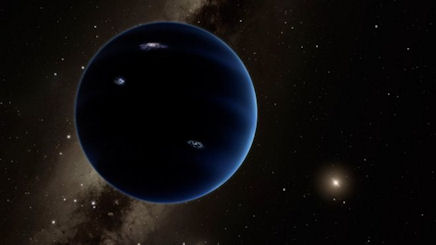
Image credit: Caltech
The discovery of some more of these objects by OSSOS has re-ignited that debate, for and against (7). The arguments presented by sceptics and advocates of Planet Nine are becoming increasingly complex and esoteric. There are good arguments made by both sides about whether there is still a reasonable case to answer. For Mike Brown, the problem of observational bias in the data is not as big as is being made out by his sceptics. Nonetheless, the extra dataset of objects provided by OSSOS requires a new statistical analysis of whether the observed correlation of properties is non-random (it extends the cluster from six to ten objects). He has written a paper setting out some new calculations, and on the basis of these has concluded the following:
"We have developed a method to rigorously estimate the longitude of perihelion bias for Kuiper belt observations. We find that the probability that the 10 known Kuiper belt objects with semimajor axis beyond 230 AU are drawn from a population with uniform longitude of perihelion is 1.2%. Combined with the observation that the orbital poles of these object are also clustered, the overall probability of detecting these two independent clusterings in a randomly distributed sample is 0.025%. While observational bias is clearly present in these observations, it is unlikely to explain the observed alignment of the distant eccentric Kuiper belt objects." (8)
Let's say Dr Brown is right when he argues that there is a strong mathematical case for the existence of an unseen body corralling these distant objects. Where is it, and when will it be observed for the first time? There are several groups of astronomers on the case, using the Japanese 8m Subaru telescope in Hawaii to scan the parts of the sky considered mostly likely to be hiding the elusive world. But it's challenging, even given the size of this telescope:
"Greg Laughlin, an astronomer at Yale University, says, “Our best estimate for its current position and brightness put it about 950 times farther than Earth from the sun.” As faint as the tiniest moons of Pluto, Planet Nine would be barely two pixels wide on the Hubble Space Telescope’s camera. Searchers could easily miss it among random speckles of sensor noise and the twinkling of distant and variable stars. And because the planet is so far from Earth, near the far end of a highly elliptical path that takes at least 15,000 years to complete, astronomers have to wait a day or more between successive photographs of the right patch of sky to see the planet shift its apparent position relative to the much more distant stars." (1)
Archived data from other sky searches is also being pored over to see if evidence for the planet already exists. It has often been the case in the history of planet discovery that the new planet had been previously observed, but not initially recognised for what it is. That may well be the case with a distant Planet X body, whose lateral motion across the sky is miniscule compared to closer objects in the solar system. It could have readily been misidentified as a background star, or other deep space object.
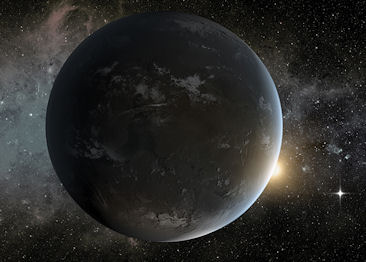
Image credit: Ames/JPL-Caltech/NASA
Astronomers are beginning to use complex artificial intelligence programmes to search for exoplanets, using archived data from the sky searches conducted by the Kepler Space telescope. These kinds of analyses are in their infancy, but could potentially bring forth many distant planets lost in the murky white noise.
"The [Kepler] team is also working on implementing a machine-learning process using an algorithm called the random forest, which will be trained with data already categorized by Kepler scientists. Once it’s up and running, the software should be able to speedily differentiate false positives and data artifacts from promising candidates." (9)
There is hope among scientists that a similar approach could pull Planet Nine out from the woodwork (1), which would effectively make any newly discovered planet in the solar system the first to be found by machines!
Written by Andy Lloyd, 19th August 2017
References:
1) W. Wayt Gibbs "Is There a Giant Planet Lurking Beyond Pluto?" 31 July 2017,
2) Andy Lloyd "Dark Star: The Planet X Evidence" Timeless Voyager Press, 2005
3) Andy Lloyd "Missing Angular Momentum and the Dark Star" 23 February 2015
andylloyd.org/darkstarblog23.htm
4) R.F. (full name known to me) "Speculations on the Sun's Dark Star Companion, According to Physics" 14 February 2015
5) Konstantin Batygin & Michael Brown "Evidence for a Distant Giant Planet in the Solar System" The Astronomical Journal, 151: 2, 20 January 2016
6) Andy Lloyd "New Arguments about Planet Nine Cluster" 23 June 2017
andylloyd.org/darkstarblog51.htm
7) Andy Lloyd "Planet Nine: Are They Digging in the Wrong Place?" 3 July 2017
andylloyd.org/darkstarblog52.htm
8) M. Brown "Observational Bias and the Clustering of Distant Eccentric Kuiper Belt Objects" The Astronomical Journal, 2017, 154: 2
9) Rachel Courtland "What’s Next for the Kepler Planet Hunter" 17 September 2013,
Sub-Brown Dwarf Twins may Reveal Origins of Free-Floating Planets
Much of my current research interests lie with the location of massive planets in interstellar space. Star systems are extensive tracts of 3D real estate, with the gravitational effects of the central star felt for a very considerable distance into surrounding space. The Sun, for instance, can control objects which lie as far as a light year out, which represents a full quarter of the distance to the nearest star. These kind of distances are enormous compared to the limits of what most people would identify as the edge of the solar system, which might extend out to, say, the most distant known planet Neptune, or the Kuiper Belt beyond it, or perhaps to the heliopause, which marks the limit of the Sun's magnetic field influence. The rest of the solar system beyond is vast, peppered by comets within the inner and outer Oort Cloud. This vast zone is technically in interstellar space, but objects within it are shepherded into orbits encircling the Sun.
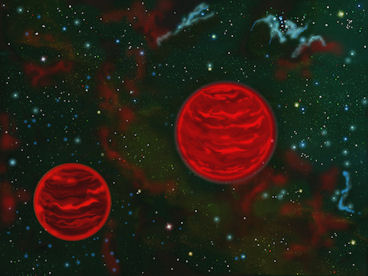
Image credit:
Gemini Observatory/Jon Lomberg Illustration
Planet Nine would fall into this category. Its existence, if proved, would extend the popular conception of the edge of the solar system from Neptune's 30AU out to perhaps twenty times that distance, perhaps more. in which case, the common definition for the edge of the solar system would change radically. But Planet Nine would be considered by astronomers to lie in interstellar space, within the flow of the broader galactic tides with their attendant Interstellar Materials (ISM), gas and dust and so on. So, it interests me as to whether planets can form and grow in such environments, well beyond the traditional scope of the protoplanetary disks that collect, rotate and evolve into planets during the early stage of a star system's lifecycle.
Planets are known to exist in the space between stars. They are labelled as free-floating planets, sometimes planemos. It is tricky enough to spot planets around stars, despite the gravitational tugs they exert on the parent stars. It is far more difficult to find similar objects floating through the void, disconnected. So, observational bias is possible here, in several ways. Firstly, there's the exponential increase in difficulty to find planet-sized objects in interstellar space compared with similar objects orbiting stars (with the exception of young sub-brown dwarfs, which are self-luminous for a relatively short period in their early lives, quickly burning up the available fuels in their atmospheres before their lights are snuffed out forever). Secondly, there is the traditional assumption that planets are going to be similar to those we already know about - predictably furrowing obvious tracks close to their parent stars. So, those kinds of planets are sought over possibilities unthought-of. Thirdly, mechanisms for planet-formation favour accretion close to parent stars, within the proto-planetary disks, over, say, formation of planets independently in interstellar space of local nebulae. These assumptions and observational constraints add up to a significant bias in favour of the status quo.
Yet, the observation of young free-floating sub-brown dwarfs shows how wrong those assumptions can be. I suspect that there are vast quantities of planets to be found in interstellar space, substantially outnumbering those around stars. It is already suspected that the categories of planets which are the easiest to find in interstellar space (the brightest needles in the haystack) - the sub-brown dwarfs, which I often call 'dark stars' - probably outnumber stars. Their numinous presence has been deduced within moving groups of stars. But I think this is the tip of a massive celestial iceberg. Because it fails to consider the potential for never-luminous planets at the lower ends of the planetary spectrum inhabiting the space between stars (gas giants, ice giants, super-Earths, terrestrial planets). Simply put, it is impossible to find these. Absolutely impossible. So, we are unable to quantify their populations. Assumptions are then made, which seem reasonable of course, because of underlying bias towards what we already know. But it is absolutely possible that interstellar space is packed full of planets. We would simply never know.
I've written about this before, drawing the attention of readers to concrete examples like the sub-brown dwarf 2MASS J11193254–1137466, thought to be a member of the large moving group of stars known as the TW Hydrae Association (1). Now, it turns out that this fascinating object may actually be a binary pair of smaller sub-brown dwarfs (2). Basing their calculations on the distance and age of the TW Hydrae Association, William Best of the Institute for Astronomy, University of Hawaii, and colleagues think that the distance between the two sub-brown dwarfs is about 4 astronomical units - an equivalent distance from the Sun to the outer asteroid belt. They're of equal mass (about 3.7 Jupiter masses each), and are rotating around one another (3). They are remarkable both for their low masses as sub-brown dwarfs, and also their identity as a binary coupling, free-floating in interstellar space.
Recent work has shown that stars may all begin life as binary objects, which emerge from 'dense cores' within birth clusters (4). Later in the star's evolutionary journey, the binaries may, or may not, split apart. In that sense, then, it may not be too much of a surprise that a relatively young duo of sub-brown dwarfs (a mere 10 million years old, it is estimated) would be found revolving around one another. But that would be assuming that they have formed within their own segregated dense core, away from a larger parent star, rather than having been ejected very early on from a larger system. Some massive free-floating planets and brown dwarfs are thought to form from tiny nebula fragments, known as Gahm globulettes, which break away from the edges of larger nebulae (5). So, they may have formed in this way, from a dispersed dense core of dust and gas to create a binary sub-brown dwarf system independent of the rest of the stellar cluster.
However, it's not even clear at this stage whether the twins belong to the TW Hydrae Association (this is thought to be an 80% likelihood). But if they are, then the relative proximity of the rest of the grouping of stars would provide a potential basis for their ejection from one of their larger neighbours. One would then have to imagine this duo being flung off from a parent star, flinging off into interstellar space like a planetary sized celestial bolas. But is it possible that they evolved independently, like stars do, but on a much smaller scale? Could the same happen for regular, planetary-mass objects, forming outside of the sizeable stellar nurseries? I wonder...
Written by Andy Lloyd, 19th August 2017
References:
1) A. Lloyd "More Dark Stars than Stars in Milky Way" 4 March 2017
andylloyd.org/darkstarblog48.htm
2) Susanna Kohler "Discovery of a Free-Floating Double Planet?" 5 July 2017, with thanks to Carlos
3) William Best et al "The Young L Dwarf 2MASS J11193254−1137466 Is a Planetary-mass Binary" ApJL, 2017, 843, L4,
4) Robert Sanders "New evidence that all stars are born in pairs" 13 June 2017,
5) Gösta Gahm et al "Mass and motion of globulettes in the Rosette Nebula", 11 May 2013,
Lessons from Dagon
Many exoplanets have been discovered orbiting distant stars over the last few decades. Most are inferred from wobbles in the parent star's position in space. In other examples, a massive exoplanet might pass in front of the star periodically, slightly eclipsing the star and lowering its luminosity for a short time. Seeing this periodic variability enables astronomers to infer the planet's presence. Less common are directly observed exoplanets. Planets are difficult to spot in the overwhelming glare of the star, rather like trying to see a lit match behind full-beam headlights.
The first planet to be directly observed in visible light was Fomalhaut b, back in 2008. It turns out to be a very unusual world orbiting a star which is already notable for an immense debris disk located in an equivalent zone to our Kuiper Belt. I discussed Fomalhaut b in a scientific paper looking at mechanisms for planet-building in the outer solar system (1). I related how this presumed gas giant exoplanet was enshrouded in an immense cloud of dust. The dust cloud was the feature seen by the Hubble Space Telescope back in 2008. But probing the cloud in infrared using the Spitzer Space Telescope had failed to find the planet itself. At the time of writing, I was conscious of the arguments about Fomalhaut b, and how this might impact upon my own hypothesis about dust clouds obscuring outer planets from view (2). What I hadn't realised at the time (and should have!) is the very weird nature of Fomalhaut b's orbit.
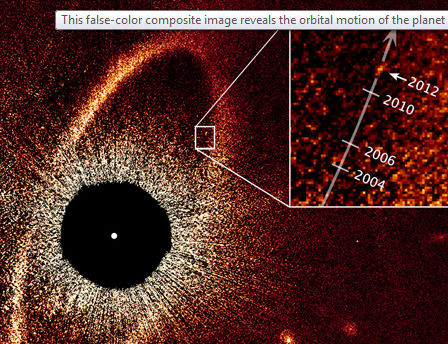
The exoplanet Fomalhaut b will pass across the main debris disk within 20 years.
Image credit: NASA (HST)/ESA
Returning to this subject this week, whilst writing my new non-fiction book about the origin of Planet X, I did some more research on this famous exoplanet. The mystery provided by this quirky orbiting patch of light has been ongoing for almost a decade, providing sufficient notoriety for Fomalhaut b to be given the name Dagon, after the Semitic half-man, half-fish deity. Dagon is equated with the Babylonian deity Oannes/Adapa, the first of the seven antediluvian sages known as the Apkallu. Half-planet, half-dust. But, like the Apkallu, is it capable of teaching us knowledge, and the art of civilisation? We shall see...

Perhaps the dust cloud mystery is the most unusual feature of this world (assuming it is just a single massive world under that shroud), but further analysis by NASA in 2013 provided data about its orbit. It turned out that Fomalhaut b's orbit is highly elliptical, ranging from a perihelion of about 50AU out to an aphelion of about 300AU (3). An equivalent object in the solar system would be an extended scattered disk object, beyond the Kuiper belt, like Sedna. Except that this is a gas giant planet. I realised then that this unusual exoplanet provides an even better precedent for a dust-enshrouded Planet X object.
The star systems aren't the same, of course. Fomalhaut A, a bright white star in the constellation Pisces, is twice the mass of the Sun, and quite a lot younger. There's also the matter of its enormous debris disk, the presence of which may play a significant role in the mystery. The good news is that Fomalhaut b may plough through this debris disk in the next couple of decades, if its orbit is in the same plane as the disk (alternatively, it may be inclined, and miss it altogether). If it does interact with the disk, then we will learn much from the ensuing fireworks display!
What no scientist is arguing is that Fomalhaut b may be normal. Maybe it's possible that just as comets brighten due to their halos of exuded materials, this exoplanet, which spends a huge amount of its life in the outer reaches of its star system, may come complete with a regular shroud of dust and debris. Perhaps it is the planets within the Sun's regular family that are unusual, being constantly 'cleaned' by the action of the solar wind and drag forces? Planets beyond this zone, beyond the heliopause, may be fuzzier affairs, complete with billowing winged disks of dusty debris.
Fomalhaut b may be an extreme example of a more generalised principle, then, exacerbated by its periodic interactions with the broader debris disk around its star. Most stars, like ours, do not have such a feature. So, the results of cosmic interactions are altogether less apparent. In the case of our solar system, a Planet X body enshrouded in dust might become a faint, fuzzier object for astronomers, making it indistinguishable from a distant galaxy or nebula. The heat signature of the enshrouded planet may be curtailed by this local dark nebula, making it difficult to see in infrared sky surveys. Only if the planet were to approach the realm of the rest of the planets would these dusty features increase the planet's overall luminosity, as is the case with Fomalhaut b.
I will explore this further in my new book, and continue to pitch this idea before astronomers in the meantime. I'm about 40,000 words into the book now, and excited about the wide-ranging contents of this new non-fiction title.
Written by Andy Lloyd, 23rd August 2017
References:
1) Andy Lloyd "The Cumulative Effect of Intermittent Interstellar Medium Inundation Upon Objects In The Outer Solar System" Feb 2016, DOI: 10.13140/RG.2.1.5112.5526 - an updated version (22/2/16) is available here:
2) Andy Lloyd "Dust in the Winged" 23 June 2016
andylloyd.org/darkstarblog39.htm
3) J. Harrington & R. Villard "NASA's Hubble Reveals Rogue Planetary Orbit For Fomalhaut B". Hubble Space Telescope Press Release, 8 January 2013,
Wave Action Drives Brown Dwarf Weather
Living in Britain, weather is never far from one's mind. It's notoriously difficult to predict here, and is capable of changing dramatically, often more than once in a day. No wonder it's such a talking point among British people. But the intensity of the weather here is as nothing compared to that within the atmosphere of gas giants and ice giants. Scale that up further, and we can only begin to imagine the powerful forces controlling weather patterns in a brown dwarf. The cloudy atmospheres on these giant worlds (often considered to be failed stars) contain hot patchy clouds made of iron droplets and silicate dust. Like cloud cover here, these patches build and dissipate (raining liquid iron within sand storms?), and shifts around the surface of the brown dwarf in discernable patterns, often banded at different latitudes - a feature clearly seen on Jupiter, and also Neptune.
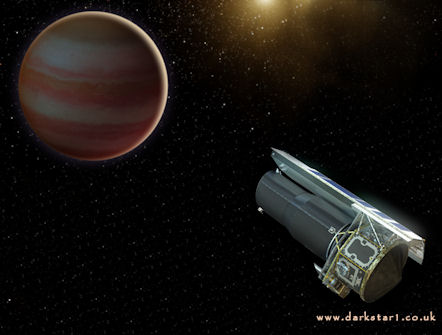
These weather patterns have now been studied in infrared using archived images of brown dwarfs using NASA’s Spitzer Space Telescope. These brown dwarfs seems to vary in brightness over time, which was thought to be due to changing atmospheric conditions. The weather patterns appear to be driven by planetary-scale wave action (1), creating immense bands of cloud cover similar in appearance to those on Neptune. Modelling these weather patterns indicates that giant waves cause large-scale movement of particles in brown dwarfs’ atmospheres, changing the thickness of the silicate clouds (2)
"“This is the first time we have seen atmospheric bands and waves in brown dwarfs,” said lead author Daniel Apai, associate professor of astronomy and planetary sciences at the University of Arizona in Tucson. Just as in Earth’s ocean, different types of waves can form in planetary atmospheres. For example, in Earth’s atmosphere, very long waves mix cold air from the polar regions to mid-latitudes, which often lead clouds to form or dissipate.
"The distribution and motions of the clouds on brown dwarfs in this study are more similar to those seen on Jupiter, Saturn, Uranus and Neptune. Neptune has cloud structures that follow banded paths too, but its clouds are made of ice. Observations of Neptune from NASA’s Kepler spacecraft, operating in its K2 mission, were important in this comparison between the planet and brown dwarfs. “The atmospheric winds of brown dwarfs seem to be more like Jupiter’s familiar regular pattern of belts and zones than the chaotic atmospheric boiling seen on the Sun and many other stars,” said study co-author Mark Marley at NASA’s Ames Research Center in California’s Silicon Valley." (1)
This Neptune-like patterns to atmospheric movements includes variable wind conditions, zonal temperature differences, and bands at different latitudes moving in opposing directions (2).
Written by Andy Lloyd, 24th August 2017
References:
1) Elizabeth Landau "Astronomers Explain the Varying Glow of Brown Dwarfs" JPL, 18 August 2017, with thanks to Mark
2) D. Apai, et al., “Zones, spots, and planetary-scale waves beating in brown dwarf atmospheres,” Science, 18 Aug 2017: 357: (6352), pp. 683-687;
science.sciencemag.org article

You can keep informed of updates by following me on Twitter:
![]()
Or like my Facebook Page: https://www.facebook.com/darkstarandylloyd